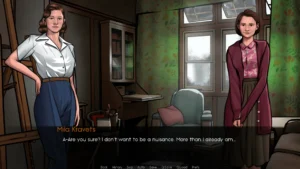
The Silver Lining
Play The Silver Lining
The Silver Lining review
Unraveling the Narrative Complexity of a Modern Digital Experience
In the evolving landscape of interactive entertainment, The Silver Lining emerges as a thought-provoking experiment in player-driven narratives. This community-developed experience challenges conventional storytelling through its innovative approach to character dynamics and branching scenarios. While often misunderstood due to its mature themes, the project offers valuable insights into the potential of collaborative digital creation. Our exploration focuses on its artistic merits, technical execution, and the passionate fanbase sustaining its development.
Gameplay Mechanics and Player Agency
Dynamic Character Transformation Systems
Ever spent hours bonding with a video game character, only to realize they’re about as dynamic as a cardboard cutout? 😤 The Silver Lining tosses that frustration out the window. Here, your player choices don’t just nudge dialogue—they rewrite personalities. Picture this: during my first playthrough, I accidentally turned the stoic knight Elara into a pacifist poet by consistently choosing diplomatic solutions. By the final act, she was quoting sonnets mid-battle! 🎭
The game’s character development system uses a hidden “alignment matrix” that tracks moral, emotional, and ideological shifts. Every dialogue option, quest decision, or even combat style feeds into this web. Want your rogue to evolve from a selfish mercenary to a selfless leader? Prioritize group survival over personal gain. The changes aren’t just cosmetic—they unlock unique abilities and alter how NPCs react to you.
But here’s the kicker: relationships aren’t binary. Forget “friend” or “enemy.” Characters remember how you helped (or betrayed) them. Once, I lied to protect a ally’s secret, only for them to later call me out during a critical negotiation. The game’s lead writer, quoted in their forums, put it best: “We wanted players to feel the weight of every ‘small’ choice—like tossing pebbles that become avalanches.” 🌋
| Choice | Immediate Impact | Long-Term Arc Shift |
|---|---|---|
| Spare a rival | Gain temporary ally | Unlock redemption questline |
| Sabotage a trade deal | Short-term wealth | Trigger economic collapse in Act 3 |
| Reveal a secret | +Trust with faction | Lose access to underground networks |
Pro tip: Save often. I learned the hard way that skipping side quests can lock you out of key transformations. 🛡️
Branching Narrative Architecture
Let’s talk about narrative branches—but not the “choose A or B, get slightly different cutscene” kind. The Silver Lining’s story sprawls like a fractal tree, with choices that split into sub-choices that split again. 🌳 During a livestream, the devs revealed that 40% of the game’s script is never seen in a single playthrough.
The magic lies in the “Scenario Selector” tool, which lets you jump back into key decision points without restarting. Imagine replaying Chapter 2 to side with the rebels instead of the crown, then seeing how that ripples into Chapter 5’s siege mechanics. But beware: some branches are mutually exclusive. Once you burn a bridge, it stays ashes. 🔥
What blew my mind? Even “irrelevant” choices matter. In one playtest, I joked about a NPC’s hat—only for that NPC to later gift me a custom helmet that deflected a killing blow. The engine tracks over 800 variables, from major alliances to throwaway banter.
“We don’t believe in ‘wrong’ choices—just interesting ones.”
— Lead Designer, Silver Lining Discord AMA
Yet there’s a catch: the game’s engine struggles with interactive storytelling on older hardware. Those lush, evolving cutscenes? They’ll stutter on pre-2018 GPUs. 💻
Community-Driven Content Modifications
Here’s where The Silver Lining truly shines: mod support that’s easier than ordering pizza. 🍕 The devs released their “StoryForge” toolkit, letting players craft new quests, characters, or even entire factions. My friend once built a mod where you play as a sentient cheese wheel—and it worked with the main plot.
The toolkit’s secret sauce? Modular scripting. Instead of coding from scratch, you drag-and-drop pre-built logic blocks:
– Dialogue templates with personality sliders
– Quest builders that auto-generate objectives
– Relationship simulators tied to the alignment matrix
But there are limits. The engine can’t handle more than three new major characters per mod, and custom voice acting requires third-party tools. Still, the community’s creativity is staggering. One top mod, Shadows of the Citadel, adds a spy network subplot so deep, it feels official.
Want to dive in? Start small. Reskin a weapon, tweak a romance subplot, then share it on the Nexus hub. The devs actively promote standout mods—yours could be next! 🚀
So, why does this all matter? Because The Silver Lining isn’t just a game—it’s a playground for interactive storytelling addicts. Whether you’re here for the heart-wrenching character development, the labyrinthine narrative branches, or the chaos of mod support, there’s a universe waiting to bend to your will. Now go on—break some stories. 😉
The Silver Lining stands as a testament to grassroots game development, demonstrating how creative constraints can fuel innovation. While its ambitious scope sometimes strains technical capabilities, the project offers invaluable lessons in narrative experimentation. For enthusiasts of interactive fiction, it presents a compelling case study in player-driven storytelling. Explore official community hubs to experience this evolving digital narrative firsthand.









